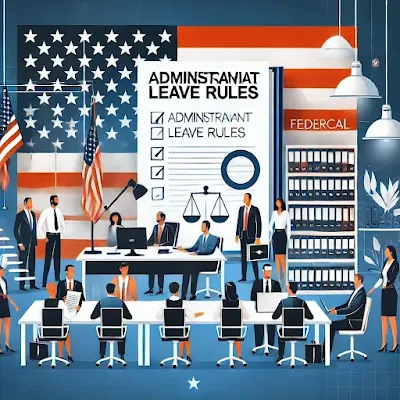OPM Finalizes Administrative Leave Rules After 8 Years: What Federal Employees Need to Know
The Office of Personnel Management (OPM) has issued its final regulations on paid administrative leave, marking a significant milestone eight years after the Administrative Leave Act was passed in 2016. These long-awaited rules establish clear guidelines for federal agencies on the use of administrative, investigative, and notice leave, addressing concerns about transparency, accountability, and misuse.
Background: The Administrative Leave Act of 2016
The Administrative Leave Act of 2016 aimed to reform how federal agencies handle paid leave, particularly in cases of misconduct or ongoing investigations. Before this law, administrative leave was sometimes used excessively, leading to employees being placed on extended leave with pay for months or even years without resolution.
The law introduced three distinct types of leave to replace generic administrative leave:
- Administrative Leave: For brief, non-disciplinary absences.
- Investigative Leave: For employees under investigation.
- Notice Leave: For employees facing proposed adverse actions.
While the legislation was enacted in 2016, the implementation of its regulations faced years of delays due to complexity and stakeholder feedback.
Key Provisions of the Final Rule
OPM's final rule, published in December 2024, establishes strict limits and conditions for each type of leave. Here are the highlights:
1. Administrative Leave
- Limited to 10 workdays per calendar year.
- Must be used for non-investigative purposes, such as inclement weather or brief office closures.
- Agencies must document the specific reasons for granting this leave.
2. Investigative Leave
- Used when an employee is under investigation for potential misconduct.
- Agencies must demonstrate that retaining the employee in their role poses a risk to safety, security, or the integrity of government operations.
- Limited to 30 workdays, with extensions requiring approval and justification.
3. Notice Leave
- Granted when an employee faces a proposed adverse action, such as suspension or removal.
- Limited to 10 workdays, with possible extensions based on case specifics.
4. Reporting and Oversight
- Agencies are required to report the use of these leave categories to OPM for monitoring.
- The rule emphasizes minimizing the use of paid leave during investigations to reduce unnecessary taxpayer costs.
Impact on Federal Employees and Agencies
For Employees
- Clarity and Fairness: The rules provide transparency about when and how administrative leave can be applied.
- Timely Resolutions: Employees under investigation or facing adverse actions can expect quicker resolutions due to strict time limits.
For Agencies
- Accountability: Agencies must now document and justify their use of leave categories, reducing the risk of misuse.
- Streamlined Processes: Clear guidelines help agencies manage investigations and disciplinary actions more efficiently.
Reactions to the Final Rule
Positive Feedback
- Transparency Advocates: Stakeholders have praised the rules for ensuring accountability and protecting employee rights.
- Good Governance Groups: Many view the reforms as a step toward greater efficiency and fairness in federal workforce management.
Concerns and Challenges
- Agency Workload: Some agencies express concerns about the administrative burden of reporting requirements and justifying leave usage.
- Unintended Delays: Critics worry that procedural complexities could inadvertently delay resolutions instead of expediting them.
FAQs About the OPM Administrative Leave Rule
1. What is the purpose of the new OPM rules?
The rules aim to standardize and regulate the use of paid administrative leave to prevent misuse, ensure accountability, and protect employee rights.
2. How does this affect federal employees under investigation?
Employees under investigation will now be placed on investigative leave, which is limited to 30 workdays. This ensures timely resolutions while maintaining fairness.
3. Are there limits to administrative leave?
Yes, administrative leave is capped at 10 workdays per calendar year and is intended for brief, non-disciplinary absences.
4. When does notice leave apply?
Notice leave applies when an employee is facing proposed adverse actions, such as suspension or removal, and is limited to 10 workdays.
5. How will these rules improve oversight?
Agencies are required to report leave usage to OPM, enabling better tracking, transparency, and prevention of misuse.
Conclusion
OPM's final rule on administrative leave is a landmark step in federal workforce management, providing clear guidelines for agencies and protections for employees. By standardizing leave categories and implementing time limits, the new regulations aim to balance accountability, efficiency, and fairness in handling investigations and disciplinary actions.
As these rules take effect, federal employees and agencies should familiarize themselves with the changes to ensure compliance and optimal workforce management.
Disclaimer: This content is for informational purposes only and does not constitute legal or professional advice. Federal employees should consult their agency's HR department or OPM resources for specific guidance.
Next Carnival Corporation (CCL) Stock: Latest Updates and Investment Insights


Community Rules & Guidelines
1: Do not post email-id or any kind of personal information.
2: Do not post your own blog/website links.
3: For Help & Support use the Contact Us form.